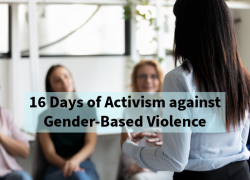
Everyone deserves to stay safe and healthy at work – but over the past several years, news stories have made clear that gender-based violence and harassment in the world of work remains a widespread problem. This spring, the Department of Labor hosted a four-part webinar series examining gender-based violence and harassment as a workplace health and safety issue.
Each webinar focused on a different industry where workers face disproportionately high rates of gender-based violence and harassment. Workers, advocates and speakers from the Women’s Bureau, Occupational Safety and Health Administration and U.S. Equal Employment Opportunity Commission discussed the unique risk factors in each industry that make workers susceptible to gender-based violence and harassment, the impact on workers and strategies to mitigate risks. Below are five key takeaways from the series.
Certain factors can increase the risk of gender-based violence and harassment
Speakers explained how certain factors such as working in isolation, in customer-facing jobs or in male-dominated jobs increase the risk for experiencing gender-based violence and harassment at work. For example, home healthcare workers often work alone in their patients’ homes, which leaves them more vulnerable to abuse from patients.
Unsafe work environments due to gender-based violence and harassment affect worker recruitment and retention
Gender-based violence and harassment negatively affect recruitment and retention of workers, especially women, because the cost of working in an unsafe environment is too high. Several workers stated that they either quit their jobs or nearly quit because of the violence or harassment they experienced at work. Being forced to leave a job to escape violence or harassment, or being wrongfully fired due to employer retaliation, also impacts workers’ ability to maintain consistent employment and wages.
Gender-based violence and harassment in the world of work negatively impacts mental health
The webinars demonstrated that experiencing gender-based violence and harassment at work has a negative impact on worker mental health, in addition to physical health. The stress and fear of being harassed, assaulted, revictimized or retaliated against can lead to many negative health impacts such as anxiety, post-traumatic stress disorder and depression. This is true not only for survivors of violence or harassment, but also for workers who are at risk or who witness it.
Worker-led solutions to prevent and address gender-based violence and harassment can make workplaces safer
Solutions to gender-based violence and harassment at work must draw on the knowledge of workers who have experienced it. These workers know what will work in their specific job contexts and what will not. The webinar series highlighted several types of worker-led initiatives that are helping to address and prevent gender-based violence and harassment in the world of work, including:
Worker-centered surveys, like those conducted by UNITE HERE Local 1, Restaurant Opportunities Centers United and National Nurses United. These collect worker input to properly identify, address and prevent workplace health and safety issues.
Trainings that center worker experiences, like those run by the BASTA Coalition of Washington, which provide farmworkers with training on addressing sexual violence, and SafeBars, which provide restaurant and bar employees with bystander intervention training. These can improve safety with their clear worker-centered prevention and response strategies.
Worker-driven policies, like those modeled in the Coalition of Immokalee Workers’ Fair Food Program. These can provide an important framework for how to address and prevent gender-based violence and harassment based on workers’ lived experiences.
Employers and unions are critical to ending gender-based violence and harassment at work
Everyone has a role to play in making workplaces safer and more respectful. Employers in particular are integral to ending gender-based violence and harassment in the world of work as they have direct control over creating a positive and accountable workplace culture and listening to worker voices. Unions are also critical because they can – and often do – advocate for and secure stronger protections from gender-based violence and harassment through tools like collective bargaining agreements.
Further reading: 5 Ways Construction Employers Can Create Safer Workplaces for Women
Further reading: How we’re implementing the National Plan to End Gender-Based Violence
Wendy Chun-Hoon is the Director of the Department of Labor’s Women’s Bureau. Jim Frederick is the Deputy Assistant Secretary of Labor for Occupational Safety and Health.

 U.S. Department of Labor Blog
U.S. Department of Labor Blog





